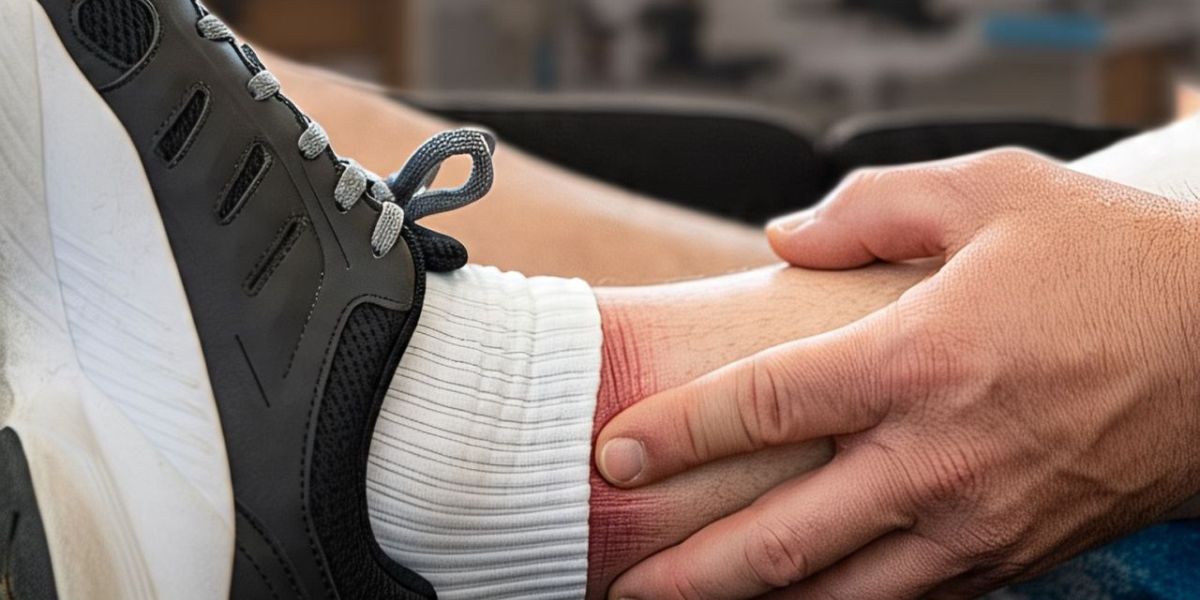What is a Plantar Fasciitis Rupture?
A plantar fasciitis rupture is a painful and serious foot injury that happens when the connective tissue at the bottom of the foot tears due to stress or pressure. This tissue, known as the plantar fascia, supports the foot arch and helps with walking. When it tears, it can cause sudden and intense heel pain, often felt during walking or standing. In some cases, people may hear a snapping sound when the rupture happens. Unlike plantar fasciitis, which involves inflammation, a rupture is a more severe injury that may lead to long-term problems if not treated. Immediate care and proper diagnosis are essential to avoid permanent fascia injury and ensure proper healing.
Causes & Risk Factors
A plantar fascia rupture usually happens due to too much pressure on the foot. One main cause is overuse injury, especially in runners or athletes. People who play high-impact sports like basketball, tennis, or football are at higher risk. When the foot is used too much without rest, it can lead to small tears in the fascia. Over time, these can turn into a full ligament tear.
Another big cause is obesity-related foot pain. When your body weight is too high, it puts extra strain on the heel tendon and foot arch. This can weaken the tissue and make it more likely to tear. Wearing improper footwear like flat shoes with no support can also lead to problems. If you step wrong or twist your foot, it may cause a sudden trauma to heel or a repetitive motion injury.
Here is a table that shows common causes and their effects:
| Cause | Effect on Foot |
| Overuse from running | Tissue breakdown |
| High-impact sports | Repeated stress on heel |
| Obesity | Extra pressure on fascia |
| Poor shoes | No arch support |
| Sudden trauma | Complete rupture |
Symptoms & Diagnosis
When the plantar fascia tears, you may hear a snapping sound in foot. Right after that, there may be intense heel pain and a feeling like something tore. Other symptoms include bruising on heel, a swollen arch, and foot stiffness, especially in the morning. You might find it hard to walk and even limping due to heel rupture.
Doctors use different methods to confirm the injury. They may ask about your symptoms and check your foot. Imaging tests like MRI for foot injury or ultrasound imaging heel help see how bad the damage is. These tests show if there is a full or partial tear.
Types of Ruptures
There are different levels of a plantar fascia rupture. A complete tear of plantar fascia is when the tissue is fully ripped. This causes severe pain and swelling. A partial tear means only some fibers are damaged. It still hurts but may heal faster. A minor rupture can happen with small injuries or overuse.
Some people suffer from severe fascia damage that doesn’t heal well. This leads to chronic plantar injury, where pain and swelling come and go for months.
| Type of Rupture | Severity | Common in |
| Complete tear | High | Runners, trauma |
| Partial tear | Medium | Athletes, overuse |
| Minor rupture | Low | Walkers, overweight individuals |
| Chronic injury | Long-term | Improper care |
First Aid & Emergency Response
If you think you have a plantar fascia rupture, act fast. The best first step is the RICE method (Rest, Ice, Compression, Elevation). This reduces pain and swelling. You should stop walking and rest your foot. Use an ice pack for heel for 15–20 minutes every few hours. Wrap your foot to reduce swelling and keep it raised.
Next, go to a doctor quickly. An emergency podiatrist visit can help with diagnosis and care. Your doctor may give you crutches for foot injury to avoid putting weight on the foot. In some cases, foot immobilization is needed to keep it still while healing.

Treatment Options
Treatment depends on how bad the injury is. For many, non-surgical treatment for heel works well. This includes physical therapy for plantar fascia to stretch and strengthen the foot. Therapists use massages, stretches, and exercises. Foot orthotics and heel support devices help reduce pressure.
Sometimes, cortisone injection is used to reduce pain. For more advanced treatment, doctors may suggest platelet-rich plasma (PRP) therapy. This uses your own blood to heal the tissue. Wearing night splints or custom foot braces can also support healing.
| Treatment | Purpose |
| Physical therapy | Strengthens fascia |
| Orthotics | Reduces heel pressure |
| PRP injection | Boosts healing |
| Night splint | Keeps foot stretched |
| Cortisone | Pain relief |
Recovery & Rehabilitation
The recovery timeline plantar rupture depends on the injury. A minor rupture may take a few weeks, while a complete tear can take months. During this time, rehabilitation for foot injuries is key. This includes physical therapy sessions and resting the foot. Doing at-home stretches for heel like towel pulls and calf stretches can help.
You must avoid running or sports until your foot is fully healed. The return to running post-rupture should be slow. Your doctor will help with recovery progress tracking, making sure you’re healing well before getting active again.
Long-Term Care & Complications
If not treated properly, a plantar fascia rupture can lead to serious problems. You might develop chronic foot pain that makes it hard to walk or stand. Some people get scar tissue formation inside the foot, which makes it stiff. Others may suffer from nerve damage in foot, which causes tingling or numbness.
You may also need heel gait correction to walk normally again. Without proper care, the injury can return. This leads to recurrent plantar issues, making everyday movement painful.
Prevention & Lifestyle
To avoid a plantar fascia rupture, take care of your feet every day. Wear arch support shoes USA brands that give your foot good support. Some of the best shoes for plantar fascia are designed with cushions and proper arches. Do daily foot stretches to keep the tissue flexible and strong.
Here are some foot care tips that help:
| Tip | Why it Helps |
| Stretch daily | Keeps fascia flexible |
| Wear good shoes | Reduces pressure on heel |
| Maintain healthy weight | Prevents extra strain |
| Rest after activity | Avoids overuse |
| Warm up before sports | Reduces risk of injury |
Following these tips is also great for injury prevention in runners and athletes. Keeping a healthy weight for foot health is one of the best ways to avoid stress on the foot sole.
For more information visit now:
FAQs & Search Queries
What happens if your plantar fasciitis ruptures?
You may feel a sudden sharp pain, hear a snap, and experience swelling and bruising in your heel or foot sole.
Can you walk with a ruptured plantar fascia?
Walking is possible but very painful, and it may cause more damage or delay healing if not treated properly.
What is the treatment protocol for plantar fascia rupture?
Initial care includes the RICE method, followed by physical therapy, foot orthotics, and sometimes PRP or cortisone injection.
How do you fix a torn plantar fasciitis?
Healing involves rest, stretching, heel support devices, and in severe cases, custom braces or surgery for full recovery.
Conclusion
A plantar fascia rupture is a serious foot condition that needs proper care. Knowing the causes, symptoms, and treatment options helps you act fast. With rest, therapy, and the right support, most people make a full recovery and return to normal life.
Welcome to Heel Tooth! I’m Lee Marvin.

